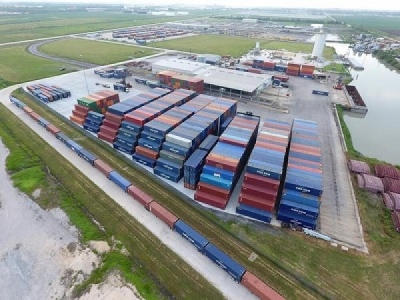
Posted on August 24, 2020
A $5 million expansion of the Port of Greater Baton Rouge’s Inland Rivers Marine Terminal container storage yard is now complete.
The yard can handle about 2,000 shipping containers at a time, moving truck traffic off of highways.
The Inland Rivers Marine Terminal is located on a barge canal near the intersection of the Mississippi River and the Gulf Intracoastal Waterway. A number of companies are located at the facility, including SEACOR AMH, which launched a container-on-barge service between Baton Rouge and New Orleans several years ago. The service takes empty barges from Memphis to several local petrochemical plants where they are filled with containers loaded with plastic pellets. The containers are then shipped down the Mississippi River to New Orleans where they are sent to plants in Europe, Asia and South America.
The expansion included 17,541 square yards of concrete poured to create nearly 4 acres of additional paved container storage capacity. The Louisiana Department of Transportation and Development’s Port Priority Program covered $3.4 million of the cost, while the port paid $1.6 million.
SEACOR has seen its barge traffic out of the inland rivers marine terminal go from 8,018 containers in 2017, to 13,685 in 2018 and 14,000 in 2019.
Greg Johnson, the port’s director of business development, said the facility is on track to handle between 16,000 and 18,000 containers this year. That’s despite a 20% drop in container traffic caused by the coronavirus-related economic slowdown.
“There is increased acceptance among regional shippers to moving their products via containers on the Mississippi River versus truck and rail,” said Jay Hardman, the port’s executive director. “As the service continues to grow, it’s catching the attention of more and more potential customers.”
Hardman has said the success of the program has staff looking at loading containers with more than just plastic pellets. Agricultural products, lumber and logs are being looked at as potential exports.
Source: The Advocate





